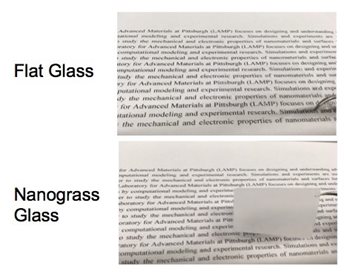Researchers at the University of Pittsburgh’s Swanson School Engineering have been working on new types of glass to improve solar module’s light capturing ability. They developed a nanostructure, which is described as looking ‘much like grass’, which has the effect of scattering light as it falls on to a solar cell placed beneath, whilst making the glass appear hazy.
In research published in the journal Optica, the glass was etched with ‘nanograss’ structures of between 0.8 and 8.5 microns in height, with the ‘blades’ each measuring a few hundred nanometers in diameter. The team found that a height of 4.5 micron’s gave the best balance of 96% transmittance and 96.2% haze, based on testing with yellow light (550nm wavelength).
Another important feature of the glass, which could have broad commercial applications in PV and other areas, is that it can be switched from hazy to clear, simply by applying water to the surface. This was a serendipitous discover made by the team, as it worked on nanostructures for solar glass.
“I was cleaning the new nanograss glass when I discovered that cleaning it with water made the glass become clear,” said project lead Sajad Haghanifar. “The water goes between the extremely hydrophilic nanostructures, making the nanograss glass act like a flat substrate. Because water has a very similar index of refraction to the glass, the light goes straight through it. When the water is removed, light hits the scattering nanostructures, making the glass appear hazy.”
Popular content
Effects of the switchable opacity on the glass’s usefulness in solar applications are not discussed in the current research, however it could also be used in LEDs, as well as for ‘smart windows’ that switch from hazy to clear. While manufacturing costs are yet to be investigated, the team expects that the glass will be cheaper to produce than current smart window solutions, which use the application of voltage to switch from hazy to clear.
The team will now conduct durability tests on the glass, and is also investigating its potential self-cleaning properties – evidence that application in solar panels is still the main focus. “Self-cleaning glass is very useful,” explains Haghanifar, “because it prevents the need for robotic or manual removal of dust and debris that would reduce the efficiency of solar panels.”
This content is protected by copyright and may not be reused. If you want to cooperate with us and would like to reuse some of our content, please contact: editors@pv-magazine.com.



1 comment
By submitting this form you agree to pv magazine using your data for the purposes of publishing your comment.
Your personal data will only be disclosed or otherwise transmitted to third parties for the purposes of spam filtering or if this is necessary for technical maintenance of the website. Any other transfer to third parties will not take place unless this is justified on the basis of applicable data protection regulations or if pv magazine is legally obliged to do so.
You may revoke this consent at any time with effect for the future, in which case your personal data will be deleted immediately. Otherwise, your data will be deleted if pv magazine has processed your request or the purpose of data storage is fulfilled.
Further information on data privacy can be found in our Data Protection Policy.